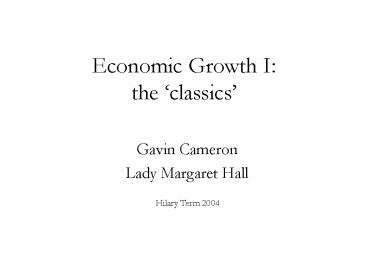Economic Growth - PowerPoint PPT Presentation
1 / 19
Title:
Economic Growth
Description:
Gavin Cameron. Lady Margaret Hall. Hilary Term 2004. the development of growth theory ... Cobb-Douglas production I ... ox.ac.uk/users/cameron/lmh/ See also: ... – PowerPoint PPT presentation
Number of Views:68
Avg rating:3.0/5.0
Title: Economic Growth
1
Economic Growth I the classics
Gavin Cameron Lady Margaret Hall
Hilary Term 2004
2
the development of growth theory
- Smith (1776), Malthus (1798), Ricardo (1817),
Marx (1867) - growth falls in the presence of a fixed factor
- Ramsey (1928), Cass (1965) and Koopmans (1965)
- growth with consumer optimisation (intertemporal
substitution) - Harrod (1939) and Domar (1946)
- models with little factor substitution and an
exogenous saving rate - Solow (1956) and Swan (1956)
- factor substitution, an exogenous saving rate,
diminishing returns
3
Kaldors stylised facts
- Per capita output grows over time and its growth
rate does not tend to diminish - Physical capital per worker grows over time
- The rate of return to capital is nearly constant
- The ratio of physical capital to output is nearly
constant - The shares of labour and physical capital in
national income are nearly constant - The growth rate of output per worker differs
substantially across countries.
4
international labour productivity
5
neo-classical production functions
- Consider a general production function
- (1.1)
- This is a neo-classical production function if
there are positive and diminishing returns to K
and L if there are constant returns to scale
and if it obeys the Inada conditions - with CRS, we have output per worker of
- (1.2)
- If we write K/L as k and Y/L as y, then in
intensive form - (1.3)
6
Cobb-Douglas production I
- One simple production function that provides a
reasonable description of actual economies is the
Cobb-Douglas - (1.4)
- where Agt0 is the level of technology and ? is a
constant with 0lt?lt1. The CD production function
can be written in intensive form as - (1.5)
- The marginal product can be found from the
derivative
7
Cobb-Douglas production II
- If firms pay workers a wage of w, and pay r to
rent a unit of capital for one period,
profit-maximising firms should maximise - Under perfect competition firms are price-takers
so they employ workers and rent capital until w
and r are equal to the marginal products of
labour and capital - Notice that wLrKY, that is, payments to inputs
completely exhaust output so economic profits are
zero.
8
diminishing returns
f(k)
output per worker, yf(k)k?
k
9
...saving a constant fraction of income
f(k)
gross investment per worker, sf(k)sk?
k
10
and a constant depreciation rate
f(k)
required investment per worker, (?n)k
k
11
the Solow model
output per worker, yf(k) k?
f(k)
required investment per worker, (?n)k
gross investment per worker, sf(k) sk?
k
12
Solow model analysis
- The economy accumulates capital through saving,
but the amount of capital per worker falls when
capital depreciates physically or when the number
of workers rises. - Saving per worker is
- (1.6)
- Depreciation per worker is a function of the
capital stock - (1.7)
- In equilibrium, the capital stock will be
constant when saving per worker equals
depreciation per worker - (1.8)
13
steady-state capital and output
- Setting equation (1.8) to zero yields
- (1.9)
- Substituting this into the production function
reveals the steady-state level of output per
worker - (1.10)
14
higher saving
f(k)
The increase in investment raises the growth rate
temporarily as the economy moves to a new
steady-state. But once the new higher
steady-state level of income is reached, the
growth rate returns to its previous level.
k
15
faster population growth
f(k)
The rise in population growth means that more
workers need to be equipped with capital each
time period, which means that less is available
for replacing depreciated equipment. This leads
to a fall in the steady-state level of capital.
k
16
the Golden Rule
f(k)
C/L
If we provide the same amount of consumption
every year, then the maximum amount of
consumption is cgoldA, which occurs at
f(kgold)nd. Aggregate consumption is
maximized where the difference between output and
investment is greatest.
I/L
k
17
summary
- The study of economic growth has a long history,
with major contributions from Adam Smith, David
Ricardo and even Karl Marx. - These early theories failed fully to take into
account the important roles played by factor
accumulation and substitution and technical
progress. - To recap, the Solow model model has two main
predictions - For countries with the same steady-state, poor
countries should grow faster than rich ones. - An increase in investment raises the growth rate
temporarily as the economy moves to a new
steady-state. But once the new higher
steady-state level of income is reached, the
growth rate returns to its previous level there
is a levels effect but not a growth effect.
18
looking ahead
- The Solow model is an advance on earlier models
since it allows for factor substitution and
accumulation. - However, saving and technical progress are still
exogenous. - In lecture two we will examine the role of
exogenous technical progress in the Solow model. - In lecture three we will examine endogenous
technical progress.
19
You can download the pdf files fromhttp//hicks
.nuff.ox.ac.uk/users/cameron/lmh/See
alsohttp//hicks.nuff.ox.ac.uk/users/cameron/pa
pers/open.pdf































